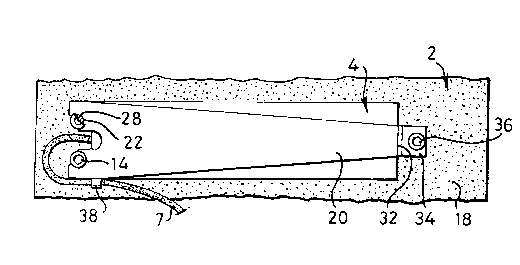Some of the information on this Web page has been provided by external sources. The Government of Canada is not responsible for the accuracy, reliability or currency of the information supplied by external sources. Users wishing to rely upon this information should consult directly with the source of the information. Content provided by external sources is not subject to official languages, privacy and accessibility requirements.
Any discrepancies in the text and image of the Claims and Abstract are due to differing posting times. Text of the Claims and Abstract are posted:
| (12) Patent Application: | (11) CA 2248845 |
|---|---|
| (54) English Title: | HEATER |
| (54) French Title: | APPAREIL DE CHAUFFAGE |
| Status: | Deemed Abandoned and Beyond the Period of Reinstatement - Pending Response to Notice of Disregarded Communication |
| (51) International Patent Classification (IPC): |
|
|---|---|
| (72) Inventors : |
|
| (73) Owners : |
|
| (71) Applicants : |
|
| (74) Agent: | KIRBY EADES GALE BAKER |
| (74) Associate agent: | |
| (45) Issued: | |
| (22) Filed Date: | 1998-09-29 |
| (41) Open to Public Inspection: | 1999-04-21 |
| Examination requested: | 1998-09-29 |
| Availability of licence: | N/A |
| Dedicated to the Public: | N/A |
| (25) Language of filing: | English |
| Patent Cooperation Treaty (PCT): | No |
|---|
| (30) Application Priority Data: | ||||||
|---|---|---|---|---|---|---|
|
A heater is disclosed comprising a foil heating
element 6 embedded in a dielectric sheet 8. A a leaf spring
20 which is curved when relaxed, clamps the embedded element
against a surface 18 to be heated.
The heater can be mounted on an internal surface of
the enclosure. Using a proprietary flexible heating
element, the heater has been run at a flux of 3.9 kW.m2.
The heater is mounted with a flexible dielectric face
directly against an internal surface of the enclosure. No
machining of the enclosure is needed since the flexible
dielectric acts as a thermal gasket.
L'appareil de chauffage présenté comprend une pellicule chauffante 6 intercalée dans une feuille diélectrique 8. Un ressort à lame 20, qui est cintré au repos, serre l'élément intercalé contre une surface 18 à chauffer. L'appareil de chauffage peut être monté sur une surface interne du boîtier. Utilisant un élément chauffant souple spécialisé, on a fait fonctionné l'appareil de chauffage à une densité de puissance de 3,9 kW/m2. Dans l'appareil de chauffage, une face diélectrique souple est montée directement contre une surface interne du boîtier. Aucun usinage du boîtier n'est nécessaire puisque le diélectrique souple sert de joint thermique.
Note: Claims are shown in the official language in which they were submitted.
Note: Descriptions are shown in the official language in which they were submitted.

2024-08-01:As part of the Next Generation Patents (NGP) transition, the Canadian Patents Database (CPD) now contains a more detailed Event History, which replicates the Event Log of our new back-office solution.
Please note that "Inactive:" events refers to events no longer in use in our new back-office solution.
For a clearer understanding of the status of the application/patent presented on this page, the site Disclaimer , as well as the definitions for Patent , Event History , Maintenance Fee and Payment History should be consulted.
| Description | Date |
|---|---|
| Inactive: IPC from MCD | 2006-03-12 |
| Inactive: IPC from MCD | 2006-03-12 |
| Application Not Reinstated by Deadline | 2001-10-01 |
| Time Limit for Reversal Expired | 2001-10-01 |
| Deemed Abandoned - Conditions for Grant Determined Not Compliant | 2000-11-27 |
| Deemed Abandoned - Failure to Respond to Maintenance Fee Notice | 2000-09-29 |
| Notice of Allowance is Issued | 2000-05-26 |
| Letter Sent | 2000-05-26 |
| Notice of Allowance is Issued | 2000-05-26 |
| Inactive: Approved for allowance (AFA) | 2000-05-10 |
| Inactive: Applicant deleted | 2000-04-18 |
| Inactive: Correspondence - Formalities | 1999-10-29 |
| Inactive: Filing certificate - RFE (English) | 1999-10-06 |
| Request for Priority Received | 1999-07-13 |
| Letter Sent | 1999-06-15 |
| Inactive: Single transfer | 1999-05-28 |
| Application Published (Open to Public Inspection) | 1999-04-21 |
| Inactive: First IPC assigned | 1998-12-02 |
| Inactive: IPC assigned | 1998-12-02 |
| Classification Modified | 1998-12-02 |
| Inactive: IPC assigned | 1998-12-02 |
| Inactive: Courtesy letter - Evidence | 1998-11-17 |
| Inactive: Filing certificate - RFE (English) | 1998-11-10 |
| Filing Requirements Determined Compliant | 1998-11-10 |
| Application Received - Regular National | 1998-11-09 |
| Request for Examination Requirements Determined Compliant | 1998-09-29 |
| All Requirements for Examination Determined Compliant | 1998-09-29 |
| Abandonment Date | Reason | Reinstatement Date |
|---|---|---|
| 2000-11-27 | ||
| 2000-09-29 |
| Fee Type | Anniversary Year | Due Date | Paid Date |
|---|---|---|---|
| Registration of a document | 1998-09-29 | ||
| Application fee - standard | 1998-09-29 | ||
| Request for examination - standard | 1998-09-29 |
Note: Records showing the ownership history in alphabetical order.
| Current Owners on Record |
|---|
| LUCENT TECHNOLOGIES INC. |
| Past Owners on Record |
|---|
| MARTIN MICHAEL MARK KEEGAN |
| WILLIAM GEORGE GATES |